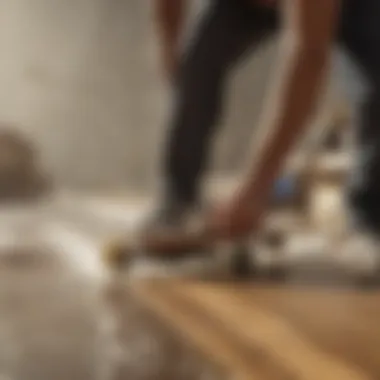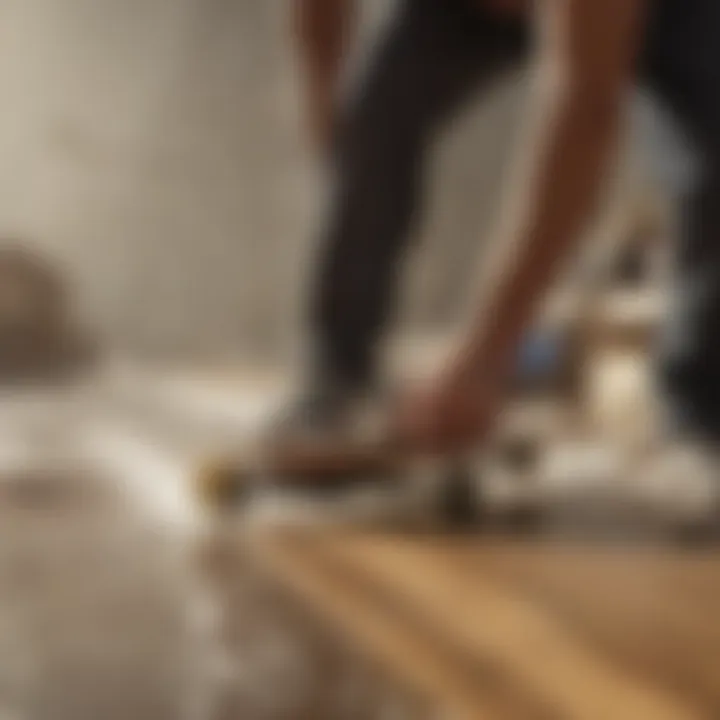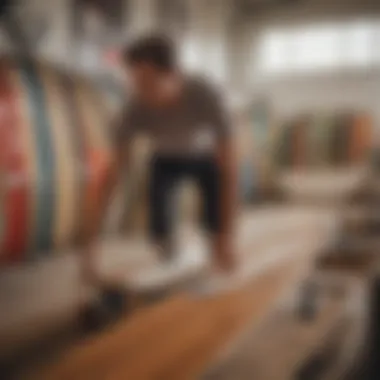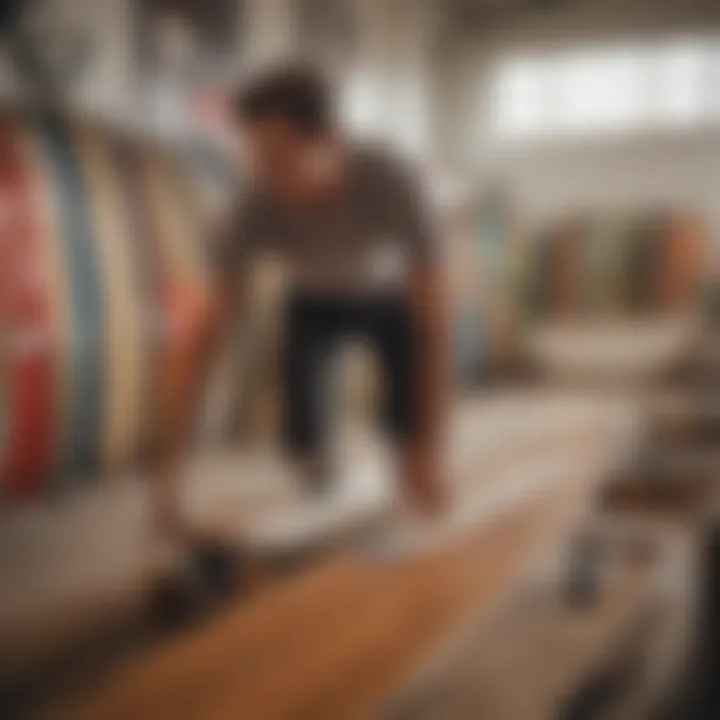The Artistry and Evolution of Longboard Shapers


Intro
Longboarding is not just a sport; it's a culture, a lifestyle that combines the thrill of riding with the artistry behind the boards themselves. At the heart of this culture are the longboard shapers, individuals who pour their creativity and technical skills into crafting these unique skateboards. This piece aims to shine a light on their essential role in shaping the future of longboarding. From historical insights to intricate board designs, we dive into the nuances that make this craft so compelling.
Help thyself understand how these artisans have influenced the evolution of longboarding as we know it today. Their work is a fine blend of science and art, where materials, techniques, and styles come together to create boards that not only perform well but also resonate with individual riders.
Longboarding, like any art form, requires understanding the tools of the trade. This is where the craftsmanship of longboard shapers becomes evident, as they carefully select materials and apply techniques honed through years of experience. Casual riders may view longboards simply as a means of transport; however, for those in the know, each board tells a story.
As we turn the pages of longboarding’s history, we will explore how these shapers contribute to a broader narrative. We aim to outline the connection between the shapers and the community, delving into the essence of longboard culture. Through technical perspectives, we will also look at the emerging trends in longboard shaping and how these are likely to shape future practices.
Join us as we carve through the world of longboard shapers and uncover the layers of craftsmanship, innovation, and individuality that fuel this vibrant aspect of longboarding.
Gear Essentials
When it comes to longboarding, having the right gear can make all the difference. While the longboard itself is the centerpiece, the gear that rides along with it plays a crucial role in enhancing the overall experience. Here, we’ll discuss what you need to ride smoothly, as well as tips on keeping your gear in top shape.
Top Picks for Longboard Gear
- Longboards: Here, you have a variety of shapes and sizes to choose from; whether you prefer a classic pintail or a more advanced drop-through design, find what suits your riding style. Brands such as Land Yachtz and Arbor offer great options that balance performance and aesthetics.
- Bushings: Don’t underestimate the importance of bushings; they affect your ride’s stiffness and responsiveness. Brands like Bones provide reliable options that can suit most longboards.
- Protective Gear: Helmets and pads cannot be overlooked. Brands like Triple Eight offer excellent protection without compromising on comfort.
"The right gear is like the right paintbrush for an artist. It allows for expression and mastery.”
Maintenance and Care Tips for Gear
Keeping your gear in good condition extends its life and optimizes performance. Here are a few straightforward tips:
- Check your wheels: Regularly inspect the wheels for wear and tear. Replace them if they show excessive signs of damage.
- Lubricate bearings: Clean and lubricate your bearings at least every few months to ensure a smooth ride.
- Inspect hardware: Periodically check screws and bolts for tightness. Nothing worse than losing a wheel mid-ride.
- Store properly: When not in use, store your longboard in a cool, dry place to prevent warping.
With the right gear and proper maintenance, longboarding can elevate from a casual ride to an exhilarating experience, ensuring you stay safe while having the time of your life.
Techniques and Tips
As a longboarder, the journey doesn’t stop at merely having the gear; mastering techniques is pivotal. Below I'll share some foundational insights that range from beginner tips to advanced techniques that help enhance your skills.
Beginner Tips for Longboarding
- Start Slow: It’s crucial to familiarize yourself with your board before trying anything fancy. Find flat surfaces to practice balance and control.
- Foot Positioning: Understand where to place your feet. Your back foot should be on the tail while your front foot balances near the center.
- Learn to Stop: Mastering stopping techniques like foot braking and carving is vital before hitting steeper terrains.
Advanced Techniques for Skill Enhancement
- Carving: Fine-tuning your carving technique can vastly improve your control and performance. Focus on weight distribution to steer better.
- Sliding: Once you gain confidence, try learning to slide. Start with stand-up slides and progress to more challenging styles like the Coleman slide.
- Downhill Racing: For those with a need for speed, downhill racing requires precision and foresight. Adequate gear, such as full-face helmets, should be non-negotiable here.
From shapers to riders, longboarding encapsulates a vibrant community. Whether you're just starting or you're an advanced rider seeking to enhance your skills, understanding these essential elements will keep you on the right track.
The Role of Longboard Shapers in the Industry
Longboard shapers serve as the backbone of the longboarding community, intertwining artistry with boarding culture in ways that are often underestimated. Their role is not just to create surfboards; it’s about crafting experiences. A well-shaped longboard directly influences how riders engage with the water, the streets, or the mountains. Each board crafted has a story behind its curves, angles, and materials, echoing the ambitions and fantasies of the riders themselves.
Definition of Shapers
In the simplest terms, shapers are artisans who convert raw materials into longboards, with skills that blend artistry and science. Consider them as sculptors, yet instead of marble or clay, they work primarily with wood, fiberglass, and foam. Each longboard they create becomes a unique entity, tailored to specific performance criteria, styles, and rider preferences. Without shapers, the longboarding landscape would be barren; boards would be mere pieces of wood, lacking soul and character.
Significance in Longboard Evolution
The evolution of longboarding has been remarkably influenced by shapers who have pushed the boundaries of design and performance. Historically, their innovations have mirrored cultural shifts, social trends, and even advancements in materials technology. From the early wooden logs of the 1960s to the featherweight, high-performance boards of today, shapers have been at the forefront, crafting tools that resonate with the spirit of longboarding.
This significance can be highlighted with several key points:
- Influential Designs: Many styles of longboarding—like cruisers, downhill boards, and freeride boards—are direct results of shapers responding to competitive demands and rider desires.
- Community Connection: Shapers often shape more than just boards; they shape communities. Their workshops have become hubs for local riders, fostering a shared understanding and passion for the sport.
- Personalized Experience: They go beyond functionality and performance by offering customization, allowing enthusiasts to imprint their personality onto the boards they ride.
"The right board can transform a rider’s experience and connection to the sport—it’s like finding the perfect pair of shoes that fit just right."
As we delve deeper into the world of longboard shaping in subsequent sections, the intrinsic value of shapers will continue to reveal itself. Every curve, every selection of materials, and every technique used speaks volumes about their impact on the sport. In understanding shapers, we grasp the essence of longboarding itself.
A Brief History of Longboarding
The history of longboarding serves as a backbone in comprehending its evolution and understanding how it has positioned itself within broader skate culture and alternative sports. Understanding this history fosters appreciation for the craftsmanship involved and sheds light on the future trajectory of the sport and its community. Individuals who engage with longboarding can thus gain insight into the cultural significance, and the artistic expressions tied to shaping techniques, which may enhance their experience on the board.
Origins of Longboarding
Longboarding is not some modern invention crafted overnight. Its origins are steeped in the rich tradition of surfing. Back in the 1950s, surfers on the West Coast started looking for ways to ride the waves when sea conditions weren't favorable. They would take old surfboards, attach wheels to them, and roll down the streets. These "sidewalk surfing" sessions marked the genesis of longboarding, a blend of surfing and skating practices. Contextualizing this allows one to appreciate how the historical interplay between surfing and land-based riding is crucial to understanding the culture that surrounds longboarding today.
As time went on, longboards naturally evolved in design and size, mirroring the changes in skateboarding techniques. By the late 1970s, the introduction of wider wheels and trucks allowed for smoother rides and better stability, vital for maintaining speed during downhill runs. This era saw longboarding shift from an alternative recreational activity to a more defined sport, enticing one and all - from casual riders to serious enthusiasts.
Cultural Impact Over Decades
Throughout the decades, longboarding has carved its niche in various cultures worldwide, reflecting the spirit of freedom and creativity. From being a mere offshoot of skateboarding, it has developed into a subculture that resonates with individual expression and community bonding. The longboarding scene has fostered a unique identity, seen vividly in styles, events, and rider camaraderie.
Key highlights include:
- 1980s Skate Videos: The emergence of skate videos showcased not just tricks but also lifestyle elements, further romanticizing the culture.
- Influence of Music: Genres like punk and reggae became intertwined with longboarding, evolving into a broader cultural movement.
- Modern Competitions: Events such as the “Downhill World Cup” introduce exciting dynamics by bringing skilled riders together to compete on breathtaking terrains.


"Longboarding is more than just a sport; it's a lifestyle that connects us, allowing self-expression while we ride together."
Over the years, despite market fluctuations and technological shifts, the longboarding culture has retained its core values, creating an inclusive community that celebrates shared experiences and adventure. Understanding this cultural journey enriches appreciation for the craft of longboard shapers and makers who continually push boundaries, fostering the sport’s growth and the joy it brings to countless enthusiasts.
Materials Used in Longboard Shaping
When one dives into the meticulous craft of longboard shaping, the materials used hold as much significance as the skills of the shaper themselves. The choice of materials can dramatically influence the performance, durability, and aesthetics of a longboard. Understanding these elements not only enriches the knowledge base of riders but also highlights the evolving nature of the sport and its artistic expressions.
Shapers are constantly treading the tightrope between traditional crafting methods and modern advancements in materials. This intersection creates boards that are not only functional but also tailored to the unique style and needs of the rider. Let's unravel the nuances of these materials.
Wood Varieties
Wood has long been the backbone of longboard production, with its natural flexibility and strength. Traditionally, many boards are crafted from various species of wood, each possessing distinctive qualities that influence the ride.
- Maple is a common favorite. It's dense and strong, providing excellent pop which is great for tricks.
- Bamboo, on the other hand, is gaining traction for its lightness and eco-friendliness. Its natural spring adds a nice flex, making it ideal for cruising.
- Birch offers a balance between flexibility and strength, often found in boards intended for downhill racing.
The aesthetic appeal of wood can’t be overlooked, either. From rich grains to various stains, wood boards can be as much about visual appeal as they are about performance.
"Using high-quality wood varieties not only enhances performance, but also showcases the artistry of shaping."
However, there's more to consider than just wood type. Other aspects like layering techniques and how the boards are bonded can also have a significant impact on durability and performance.
Innovative Materials
In this age of technology, shapers are not bound to the traditions of yesteryears. Innovative materials have found their way into longboarding, reshaping the landscape of what's possible.
- Carbon Fiber: Lightweight yet incredibly strong, carbon fiber is a gamechanger for performance-focused boards. It provides increased stiffness and energy return, making it a popular choice for downhill racers.
- Fiberglass: Often used in combination with wood, fiberglass adds strength and durability, allowing boards to take far more abuse than their wood-only counterparts.
- Recycled Materials: As sustainability takes precedence, some shapers are using recycled plastics and composite materials. This not only helps reduce waste but can also create uniquely designed boards with character.
- Epoxy Resin: While traditional poly resins are still used, epoxy resin offers a safer, more durable option. It bonds well with various materials, enhancing both strength and longevity.
Techniques of Longboard Shaping
Understanding the techniques of longboard shaping lays the groundwork for appreciating the craftsmanship behind these surfboards. The artistry and technical knowledge involved in this process can significantly influence not just the aesthetic but also the performance characteristics of longboards. Shapers must balance tradition with innovation, ensuring that each board meets the specific demands of riders while also staying relevant to changing trends in materials and styles.
Traditional Hand Shaping
Traditional hand shaping is the essence of longboard crafting. This technique, often regarded as the purest form of board shaping, involves the shaper using tools like planes, saws, and sanders to mold the board to the desired specifications. It’s a hands-on approach that allows for intimate control over every curve and contour.
Each shaper develops a unique style through the years, often influenced by their own riding experiences and the local surf conditions. The result is not just a board but a piece of art, often reflecting the shaper's personality and philosophy towards surfing.
Some advantages of traditional hand shaping include:
- Customization: Each board can be tailored to a rider's specific preferences, allowing for a personal touch in both performance and design.
- Skill Development: Mastering hand shaping techniques takes years of experience, often passed down through generations. It creates a deep understanding of how each element of design, such as rocker and flex, affects rideability.
- Connection to the Craft: Shapers who handcraft acquire a deep-rooted appreciation for the materials and process involved, leading to more thoughtful designs.
However, this method does present challenges, particularly time constraints and consistency issues. Not every shape can be replicated exactly, leading to a unique experience for each rider.
Modern Machine Shaping
On the flip side, modern machine shaping introduces a different dynamic to the longboard crafting process. With the use of CNC machines, shapers can achieve precision and consistency that traditional methods may struggle to deliver. The technology allows for intricate designs that can be replicated with astonishing accuracy, making it ideal for mass production or to meet higher demands.
Some of the noteworthy elements of modern machine shaping include:
- Efficiency: Machines can carve out shapes in a fraction of the time it would take manually, increased productivity significantly, making it easier for businesses to meet consumer demand.
- Reproducibility: The ability to create exact replicas means that riders seeking a specific design can be assured that every board will perform similarly.
- Complex Designs: With advanced software, shapers can explore more complex geometries and designs that would be hard to achieve through hand shaping.
Despite its advantages, machine shaping also faces criticisms, such as the perceived loss of craftsmanship and individuality. Some purists argue that it lacks the soul present in a hand-shaped board. As such, many shapers today find a middle ground, employing both techniques to harness the best of both worlds.
"Blending the old with the new has created a new era of longboard shaping, where tradition meets technology."
In summary, the techniques of longboard shaping—whether through traditional hand sculpting or modern machine processes—play an essential role in the longboarding culture. Both methods have their merits and drawbacks, fostering a dynamic dialogue in the community about what it means to ride and shape a longboard. Riders and enthusiasts alike benefit from this rich tapestry of techniques, making longboarding not just a sport, but a craft steeped in history and innovation.
Design Elements of Longboards
Design elements are the soul of longboards; they dictate the way a board performs in various conditions and how it feels under the rider's feet. As much as each shaper pours their creativity into the concave, the tail, and the width, these dimensions are not just playful whims. They are essential components that enhance the ride and address specific needs.
Length and Width Considerations
Length and width of a longboard are pivotal to handling, balance, and speed. Typically, the length of a longboard can vary from 28 inches to over 60 inches. A shorter board offers more maneuverability, making it perfect for tight turns and tricks—think of it as a briefcase compared to a full-sized suitcase. On the other hand, a longer board aids stability at high speeds, ideal for cruising or downhill riding.
- Shorter Boards (28 - 40 inches): Best for tricks and urban riding. They are quick and agile, letting skateboarders weave through crowded streets like a deer through the trees.
- Longer Boards (40+ inches): Provide stability and comfort during long rides. They are appreciated by those who enjoy leisurely skating along coastal paths or campus sidewalks.
Width is equally crucial; boards typically vary between 8 to 10 inches. A wider board gives the rider a more secure footing, while a narrower board can enhance speed and reduce drag. Balancing the two, much like balancing salt and pepper in cooking, can lead to a recipe for a perfect ride.
Shape Variations
When it comes to longboards, the shape matters—a lot. Different shapes cater to varying riding styles. For instance, a pintail shape, known for its pointed nose and tail, is a classic choice for cruising and carving. It resembles a finished dish, beautifully plated and enticing, promoting smooth rides even at slower speeds.
On the flip side, there are drop-through boards that allow for easier pushing. The deck hangs lower to the ground, providing a surprisingly accessible riding experience, especially for beginners who might feel wobbly like a baby learning to walk.
- Common shapes include:
- Pintail
- Drop-through
- Drop-down
- Torpedo
Each of these shapes has nuances in how they interact with the road, from flexibility to rigidity, which affects everything from speed to control.
"The design is the least understood aspect of longboarding. Every angle, curve, and line impacts performance. An experienced rider can tell the difference just by looking."


Understanding design elements, particularly length, width, and shape, aren't just for fun; they are fundamental in determining the rider's experience. This interplay between art and science allows shapers to craft boards tailored to the specific whims of any longboard enthusiast.
Influence of Individual Shapers
The craft of longboarding is not merely a technical endeavor; it is an art deeply embedded with the spirit and personality of individual shapers. These artisans channel their unique perspectives into the very fibers of the boards they create. Their influence permeates through designs, riding styles, and the overall longboarding experience. This section examines the pivotal roles shapers play and how their individual characteristics translate into the broader culture of longboarding.
Notable Historical Figures
Looking back into the annals of longboarding, certain figures stand out, shaping the direction of this sport and its community. One such notable shaper is Duke Kahanamoku, whose pioneering efforts in surfing also laid groundwork for longboarding’s evolution. His vision of riding waves inspired countless individuals, merging cultures and ideas, which ultimately influenced what longboarding is today.
Another important figure is Tommy Neef, a shaper from California, who was pivotal in transitioning longer boards into the mainstream. His innovative designs focused on performance, leading to a wave of copying that seasoned the market with various shapes and materials, as competitors tried to replicate his success.
These figures demonstrate that longboard shaping is far more than a business; it embodies passion, creativity, and a deep-rooted connection to the ocean. The craft and innovation introduced by these shapers sparked a movement, enthusiastically followed by newcomers and professionals alike. Each of them left a unique stamp on the longboarding culture, proving that the influence of individual shapers resonates well beyond just the technical aspects of constructing a board.
Contemporary Influences
In the present, the longboarding landscape continues to evolve, driven by new voices and perspectives. Steven “Sonn” Sonnet represents a wave of modern shapers who prioritize sustainability alongside performance. His methodology centers around using reclaimed wood and eco-friendly adhesives, which speaks volumes about the shifting values within the longboarding community. This trend of eco-conscious practices is not simply born out of necessity; it garners respect and admiration from riders who are increasingly aware of their environmental footprint.
Moreover, Felicia West, a female shaper making waves in a male-dominated industry, has brought nuanced design innovations that cater to the needs of female riders. Her eye for detail and understanding of balance and stability has resulted in boards that feel tailor-made, enhancing the riding experience for women and encouraging broader participation in longboarding.
"Individual shapers don’t just craft boards; they shape the very essence of how the sport is experienced and shared. Their influences span from design to values such as awareness and community," notes longboarding historian Lisa Barretta.
Considering these examples, it’s clear that the contribution of contemporary shapers goes beyond the technical. They champion creativity, inclusivity, and sustainability. As these shapers forge new paths, they solidify the significance of individuality in longboarding, inspiring future generations to express themselves through both riding and shaping.
The Longboarding Community
The longboarding community plays a crucial role in the culture and evolution of the sport. In many ways, it acts like a living organism, constantly adapting and evolving while rooted in a shared passion for this unique form of skating. Longboarding isn’t just about riding a board; it’s about camaraderie, expression, and a collective identity that binds individuals from all walks of life.
One significant aspect of this community is the collaboration that occurs between riders and longboard shapers. Shapers contribute to the community by creating boards that resonate with the needs and styles of the riders. They often attend local events, foster connections with riders, and engage in conversations about what makes a board ideal for different types of riding. This interaction cultivates a sense of belonging. Riders feel their voices are heard and their preferences are catered to, which strengthens their connection to the sport.
Moreover, this community offers several benefits:
- Support Systems: Longboarding offers not only thrills but also builds friendships that can last a lifetime. Individuals often learn from one another and share tips.
- Shared Knowledge: With various styles, tricks, and techniques, riders swap advice on everything from perfecting a slide to choosing the right terrain.
- Collective Growth: Participation in group rides and events fosters a better understanding of safety and respect for the environment.
Quote:
"A thriving community is the heartbeat of longboarding; it's where passion meets purpose."
In essence, engaging actively with the longboarding community serves as a platform for personal growth, friendship, and the development of skills. As longboarders come together, they not only enhance their riding experience but also contribute to the overall culture of the sport.
The Role of Shapers in Community Building
Longboard shapers are often unsung heroes within this community. Their craft directly influences the performance and feel of longboards, shaping the way individuals experience the sport. Many shapers take the time to know their local riders, hosting workshops and offering customizations. This engagement fosters a spirit of innovation, where both shapers and riders can exchange ideas. Shapers often provide personalized solutions to riders’ demands—whether that’s customizing a board for dashing through city streets or for cruising long distances.
They understand that every rider has a unique style and preferences. For instance, a shaper might provide a different flex or carve based on a rider's weight, height, and preferred riding style. This adaptability helps cultivate a tight-knit community where feedback loops encourage iterative designs that push the boundaries of what longboards can do.
Event Participation and Sponsorship
Events, from casual meet-ups to competitive races, are essentially the lifeblood of the longboarding community. Shapers often participate in these gatherings, showcasing their latest creations and tuning into the vibe of their audience. Such interactions allow them to stay relevant, both in terms of innovation and understanding consumer needs.
Sponsoring or organizing events is another significant role that shapers play. By backing competitions and community events, they contribute to the sustainability of the sport. Local contests often rely on the support of shapers to ensure that riders have access to high-quality boards for their performances. In doing so, shapers also gain visibility and respect among the longboarding community as they align their brand with grassroots movements.
This participation also opens doors for longboarders, evident when emerging talents get discovered during such events, leading to sponsorship deals or professional opportunities. These connections help support the next generation of riders, ensuring the sport's vibrancy.
In summary, the longboarding community thrives on the connections between shapers and riders, where creativity and individual expression come to life. This dynamic not only reinforces the essence of longboarding but also supports the continuous evolution of the sport.
Customization and Personalization
Customization and personalization lie at the heart of longboard shaping, providing a unique facet that sets each board apart. The significance of these elements cannot be overstated; they allow riders to cultivate a board that speaks to their individual style and performance needs. When it comes to longboarding, it’s not simply about riding—it’s about the entire experience, which is enhanced greatly through tailored equipment.
For many, longboarding is an extension of oneself. Riders crave boards that reflect their personal aesthetic as well as their physical capabilities. A properly customized longboard can enhance balance, stability, and maneuverability, suiting the unique riding style of each individual. As a result, shapers are not just fabricating boards; they are crafting personal vehicles that align closely with their owner’s vision and preferences.
Tailored Boards for Individual Riders
The process of tailoring boards for individual riders is a deeply personal journey. Shapers often start by understanding the rider’s goals and preferences—whether they prioritize cruising, carving, or downhill speed. Once this foundation is established, several factors come into play:
- The Shape: Riders might prefer a wider board for stability or a narrow one for agility. Shapers are keen to adapt the shape to the rider's body type and riding style.
- The Deck Material: Options range from bamboo for its flex and light weight to maple for its durability and strength. The choice reflects the riding lifestyle and often personal taste.
- The Graphics: Beyond function, aesthetics play a vital role. Many riders enjoy having unique graphics that represent their personality, interests, or even local culture.
At a local longboard shop, one might find shapers using various techniques to shape a board directly according to rider specifications. The outcome? A longboard that feels as if it was made just for you, crafted with a deep understanding of what you need to ride.
Artistic Expression Through Design
Artistic expression in longboard design adds another layer of depth to the personalization process. Beyond performance characteristics, many riders view their longboards as canvases showcasing their creativity. Shapers not only focus on the technical aspects but also actively encourage expressive designs that resonate personally with the rider.
The possibilities for artistic expression are nearly limitless:
- Custom Paint Jobs: Riders can request vibrant colors, intricate patterns, or even themed artwork. Such designs form an integral bond with the board and can result in a striking visual appeal.
- Inlays and Decals: Many longboard enthusiasts explore options for inlays made from different materials, contributing to a visually stunning and unique finished product. Additional decals can further personalize the board.
- Shape and Design Elements: Asymmetrical designs and alternate shapes can showcase distinct aesthetics while serving practical functions. Shapers experiment with curves, cuts, and various tail shapes, leading to visually exciting yet functional boards.
Personalization of longboards isn't merely a trend; it is a necessary connection between the rider and their board, turning a simple ride into a unique expression of self.
Environmental Considerations in Longboard Shaping
Longboard shaping, while rooted in creativity and performance, has a growing need to reconcile with the natural environment. As the longboarding community expands, so does the awareness that the materials and methods used in crafting boards can significantly impact the planet. In this section, we will explore the importance of environmental considerations in longboard shaping, focusing on sustainable materials and eco-friendly practices.


Sustainable Sourcing of Materials
The journey of a longboard, from concept to creation, often begins with the selection of materials. Sourcing sustainable materials is not just a trend; it's a necessity. Traditional materials like wood can vary in their environmental impact. Boards made from locally sourced woods such as bamboo or maple tend to have a lower carbon footprint. Bamboo, in particular, has caught the eye of many shapers due to its fast growth rate and minimal resource needs. This plant, which can grow several feet in a single day, requires less water and does not need pesticides.
Additionally, reclaimed wood has risen in popularity. Using wood that’s been salvaged from old furniture or construction projects not only prevents waste but also provides unique and rich aesthetics to the boards. This practice emphasizes the idea that style and sustainability can go hand-in-hand.
"Choosing sustainable materials often leads to better performance and a unique character. Some boards sing stories of their past, while treading lightly on our future."
Eco-friendly Practices in Production
The shaping process itself can have a sizable impact on the environment. More shapers and companies are now embracing eco-friendly practices. Many are moving toward water-based adhesives and finishes, which are less harmful than traditional solvents. This change not only minimizes toxic waste but also fosters a healthier workspace for craftsmen.
- Waste Management: Implementing recycling and waste reduction strategies is another way shapers are helping the environment. By reusing offcuts and other materials, they can reduce the amount of waste that would otherwise end up in landfills.
- Energy Efficiency: Many longboard production facilities are also adopting renewable energy sources, like solar or wind power. This initiative reduces reliance on fossil fuels, aligning the shaping process with broader climate goals.
The emphasis on environmentally friendly practices is essential not just for ethical reasons but also because it can resonate well with consumers. Riders are becoming more informed and often seek out brands that reflect their values in sustainability. Therefore, while the challenge of incorporating eco-conscious strategies into longboard shaping may seem daunting, the long-term benefits for both the environment and the community can be profound.
Challenges Faced by Longboard Shapers
The world of longboard shaping, while brimming with creative possibilities, is not without its set of challenges. Understanding these hurdles is essential for recognizing the resilience and skill possessed by longboard shapers. This section unpacks the complexities surrounding market competition and evolving consumer trends. These elements have become increasingly vital as the sport grows, affecting techniques and designs in the longboarding realm.
Market Competition
Market competition in the longboarding industry is intense, akin to a tidal wave crashing against a rocky shore. With more players in the game, including small indie brands and large manufacturers, shapers must find innovative ways to distinguish their boards. This race often leads to an uptick in quality, as competition pushes shapers to refine their craft continuously. But it also breeds pressure, making it critical for shapers to stay ahead of the curve with unique designs that cater to niche markets.
In this competitive landscape, effective marketing strategies and brand storytelling become invaluable. Shapers are not merely crafting boards; they are weaving narratives that resonate with their audience. As younger consumers gravitate toward brands that reflect their values, shapers must create compelling visions, from sustainable sourcing to cultural connections.
"In a crowded market, it’s not just about making a board. It’s about creating a lifestyle around it."
Consumer Trends and Preferences
Consumer trends are mercurial, shifting like sand beneath a surfer’s feet. Today, riders are increasingly conscious of not only the functionality of a longboard but also its aesthetic appeal and environmental impact. Customers are looking for bespoke options, which means longboard shapers must be more attuned than ever to their audience's preferences. Personalized designs and custom shapes are increasingly in demand, reflecting a desire for uniqueness.
Longboard shapers face the challenge of adapting to these trends while staying true to their artistry. They must listen to the whispers of the community while also navigating the broader global shifts toward sustainability and ethical production. This can mean sourcing sustainable woods or utilizing innovative materials like bamboo or recycled plastics. In this way, the choice of materials isn’t just about performance; it reflects consumers’ growing insistence on eco-friendly practices.
As preferences continue to evolve, longboard shapers must remain flexible, often experimenting and iterating designs based on feedback and emerging trends. The ability to adapt is not just beneficial; it has become a necessity to thrive in this ever-changing landscape.
The Future of Longboarding
As we embark on the journey to discuss the future of longboarding, it becomes increasingly clear that this sport is at a crossroads of innovation and tradition. The way longboarding is perceived and practiced today is undeniably tied to the efforts of shapers who breathe life into each board they craft. With the relentless march of technology and shifting consumer preferences, the future promises exciting changes that could redefine how enthusiasts engage with the sport.
Innovation in Design and Materials
In recent years, the landscape of longboard design has taken a turn for the innovative. New materials, such as carbon fiber composites and advanced plastics, are surfacing, offering heightened durability and performance. These materials not only reduce weight but also enhance the flexibility and response of boards, allowing for a more dynamic riding experience.
Shapers are eagerly tapping into these advancements. For instance, brands like Loaded Boards have begun incorporating bamboo into their designs, which is not only strong but also lightweight. Such choices resonate well with the eco-conscious consumer, blending sustainability with high performance.
Moreover, developments in shape technology are making waves. Predictive modeling software now allows shapers to simulate how different designs will perform under various conditions. This means that a simple sketch on the drawing board can evolve into a finely-tuned performance machine before ever touching the actual materials.
- Key Innovations to Watch:
- Advanced materials such as carbon fiber and bamboo.
- Predictive modeling in design processes.
- Eco-friendly production practices that appeal to modern consumers.
Emerging Trends in the Community
The longboarding fraternity is not just about riding; it's a culture that thrives on community, and this aspect has evolved significantly. Today, there is a marked inclination towards inclusivity and accessibility, actively welcoming newcomers into the fold. Shapers and community leaders are pushing for local meetups and events that cater to riders of all skill levels.
Social media platforms like Instagram and Reddit have become launchpads for sharing experiences and tips, effectively bridging gaps between seasoned riders and novices. Individual shapers are using these platforms not only to showcase their artistry but also to engage directly with riders, gaining feedback on what the community seeks going forward.
"The future of longboarding is not just about the boards but the people who ride them. Community is at the heart of every turn, slide, and race."
As this community grows, the influence of shapers remains critical. They are not merely artisans; they are visionaries, guiding the sport through its next chapters.
Longboard Shaping Around the World
Longboard shaping is not merely a craft; it’s a global phenomenon that reflects diverse cultures, environments, and personal styles. This section is crucial to understanding how patterns of longboard shaping have developed in different regions and the influences behind these variations. By studying the art of longboard shaping worldwide, we can recognize the threads that connect shapers to their local communities and see how these threads weave a shared love for the sport.
Regional Variations in Styles
Longboard shapers across different continents have crafted unique styles based on local cultural influences, material availability, and environmental conditions. For example, shapers in California might favor a more surf-inspired model, utilizing materials like lightweight bamboo to create flexible and reactive boards, ideal for carving down coastal hills. Meanwhile, in places such as Japan, craftsmanship often emphasizes meticulous attention to detail, integrating traditional woodworking techniques into contemporary designs.
Some regional styles include:
- Coastal Influences: Boards designed for waves, often wider with a lower center of gravity. Common in surf hubs like Hawaii and California.
- Mountain Variation: Shapers in hilly regions often create boards optimized for downhill rides and higher speeds, featuring steeper angles for enhanced stability during descents.
- Artistic Expression: In countries like Brazil, shapers blend art into their designs, incorporating bright colors and patterns that reflect their vibrant culture.
These regional distinctions highlight how the local surroundings and culture shape board performance and aesthetic. They make longboarding itself not just a sport but a canvas for expressing identity.
Cultural Factors Influencing Designs
Cultural influences play a pivotal role in shaping longboards. Each area’s history, social dynamics, and lifestyle contribute greatly to the designs that emerge from its shapers. For instance, in South Africa, anglers influenced the design of longboards that can maneuver easily on grass, reflecting the necessity of multi-terrain usage due to the diverse landscapes. In contrast, urban centers in Europe may prioritize sleek designs that can glide smoothly through crowded streets.
Several key cultural factors include:
- Local Traditions: Longboard designs may incorporate traditional art motifs or materials rooted in the region's craft heritage.
- Lifestyle Needs: The everyday activities of a locale—whether surfing, commuting, or casual cruising—shape the type of boards crafted there.
- Community Events: Local longboarding events foster a sense of community, influencing shapers to create boards that cater to group activities like racing or downhill meets.
As we explore longboard shaping around the world, it's evident that each board tells a story. The balance of function and art reflects not just the sport but the culture it springs from, creating a rich tapestry of influences that connect riders globally.
"In every longboard, there's a slice of the shaper's world, encapsulating their journey, community, and culture."
By understanding these localized practices and cultural nuances, we can foster a greater appreciation for the artistry and thought that goes into each longboard, making it an extension of the rider themselves.



